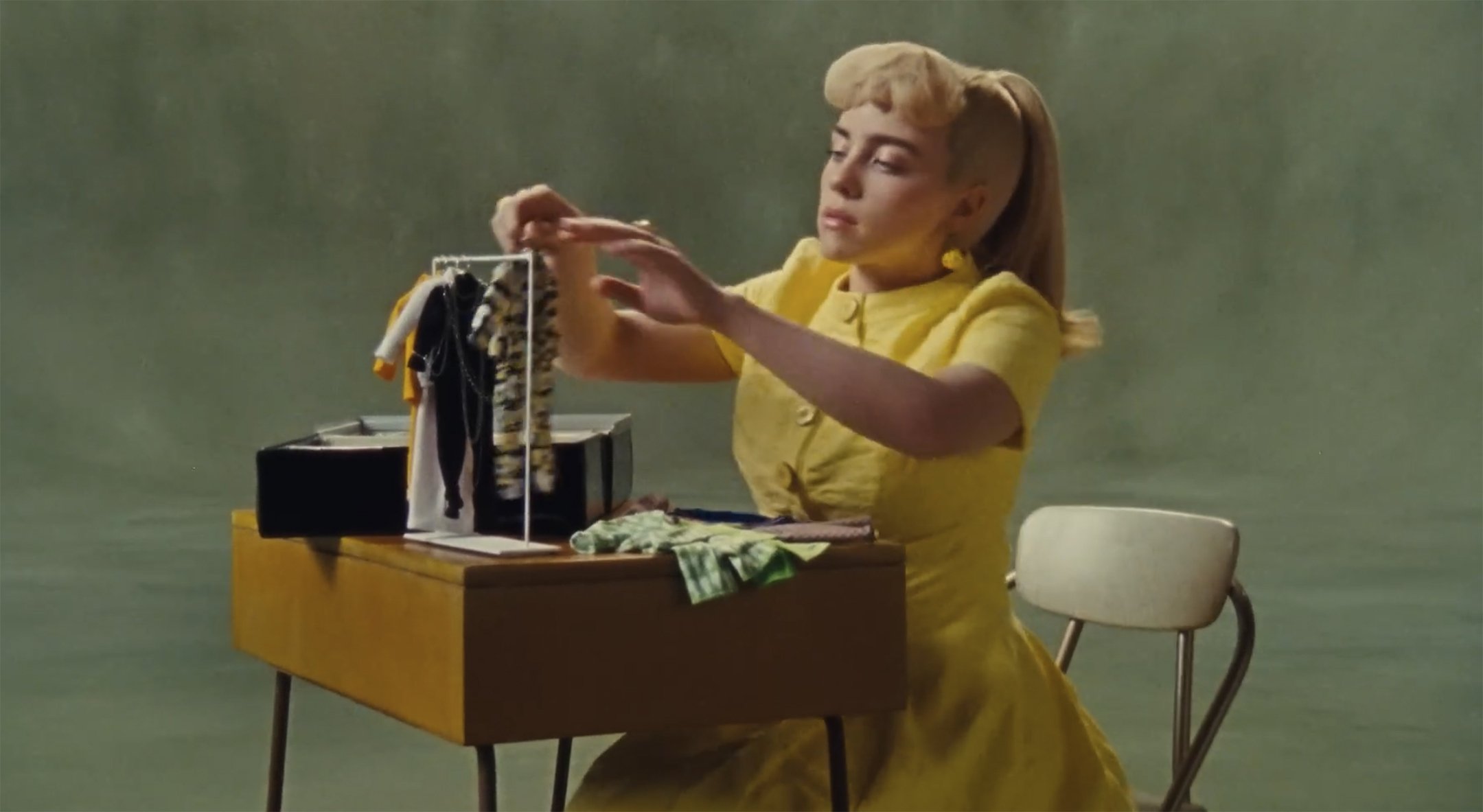While Eilish had seen Barbie before this process began — which wasn’t released yet — Scola had not, something that he found to be an asset in creating the look of the music video. “We didn’t want to try and make it feel like the movie,” he says. “It wants to be its own version of this thing. With the idea of Billie wanting it to feel like old Barbies looked, that was really the key to unlocking how to really make it feel different.”
The music video plays out in a single take, the camera moving in and out on a dolly in time with the emotional ebbs and flows of the song. Eilish is seated at an old-fashioned school desk, dressed in a vintage yellow dress that is reminiscent of classic Barbie. She opens a box with the Barbie logo on the front and begins to pull out doll-sized versions of iconic outfits Eilish has worn over the years as a performer. She arranges the clothes on a small clothing rack on the table.
The table and camera start to shake as if there is a small earthquake. Eilish determinedly continues arranging the clothes, only to be hit with a strong wind. She persists, and it begins to rain, soaking her. The rain stops and Eilish packs up the clothes, having to wring some of them out. She closes the box and leaves, leaving the camera along with the school desk.
In order to create the retro feel of the video, Eilish knew she wanted to shoot on Super 16. Scola used an Arriflex 416 with Kodak Vision3 500T stock, choosing the high-ISO emulsion in order to create the grain structure Eilish sought. He paired the camera with a Canon 8-64mm zoom. While the video features little zooming, it was utilized at the beginning to create a feeling of moving past Eilish while staying on the same side of her.
For most of the video, the changes in framing are created by a nuanced choreography between the dolly and Eilish. Dolly grip Connor Colby had the lyrics of the song taped to the back of the dolly in order to implement the needed precision. “It’s really interesting working with Billie. She has such a clear, strong perspective. That camera movement was more or less a version of a camera movement that she had filmed for me with an empty chair and a phone. I used that as a jump off. We tweaked some things on the day to work better with the effects.”
Because of the rain effect, each reset between takes would take two and a half hours while Eilish’s wig was re-applied. The crew spent a day lighting and rehearsing, and then was able to shoot three takes the next day. Scola describes: “We knew we’d be limited in the number of takes we could achieve, so the rehearsals were key in making sure that everything lined up — the shaking gag, the wind.... Billie was very particular about when these things were going to happen. We did a bunch of rehearsals while she was in hair. Once we did a few and knew what we were going for, we were able to finesse that with stand ins. When she came back, we would do one with a stand in so she could see, and then it would be time to get wet.”
Scola and gaffer Joel Marich solely used tungsten lights for the video. The stage was lit by 6K space lights, with Eilish’s key light consisting of two 20Ks pushing through muslin from as high as the stage allowed. “I think you can feel a difference in the texture and quality of the lighting that comes from quartz rather than LED on film,” says Scola. “I’m very pleased with the look of it, I think it’s a really beautiful little thing.
“I’ve done a lot of music videos. It’s where I started and it’s a thing that I love to do. When I was younger, I used to think I could make a great video even if the song wasn’t that great, or if I didn’t really love it. Now that I’m older, I don’t really feel that way. I feel like a great song really dictates if the video is going to be good or not, even if the idea is great. I think this is a perfect example. It’s a simple video in execution, but it hurts your heart a little when you’re watching it and listening to it”
Scola won the 2022 ASC Spotlight Award for his camerawork in the feature Pig. His recent work includes A Quiet Place: Day One.




